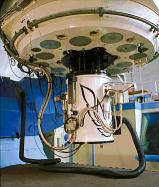
Detections of H2, H3+ and CO

| High-Resolution Infrared Spectroscopy
of Molecular Clouds and Star-Forming Regions: Detections of H2, H3+ and CO |
| Our Aims in a Nutshell... |
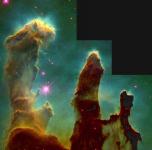 |
Introduction: Since the "discovery" of the first dense molecular clouds 30 years ago, it had been suspected that over 99% of the molecular matter in these clouds was bound up in the "invisible" H2 molecule. Similarly, H3+, also invisible to radio observations, was expected to be the cornerstone of the chemistry that forms most other molecules in these clouds. In the intervening years, astronomers had resorted to using CO as a tracer of H2, and molecular ions like HCO+ and N2H+ to estimate the relevance of H3+. In recent years, the advances in infrared and submillimeter photometry and spectroscopy has highlighted the importance of these molecular clouds to the process of star formation, for which we have only a prescriptive understanding. |
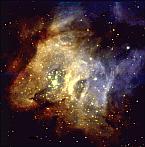 |
Where is the molecular hydrogen? Although H2 is thought to encompass well over 99% of the molecular material in an star-forming cloud, it is very unfortunately nearly invisible in its cold, quiescent form. Why is this? Symmetry; H2 is a homonuclear diatomic molecule. Although this makes it a simpler system to study from a quantum mechanical point of view, its symmetry also naturally places the center of charge and the center of mass at the same exact location. The electric dipole moment of the molecule is therefore identically zero, and so there are no permitted dipole transitions available by which the H2 molecule can radiate. It does not therefore couple to a radiation field and therefore has does not glow. At high gas temperatures, or if subjected to an ultraviolet radiation field, it can radiate weakly via forbidden electric quadrupole transitions and can be observed directly in the infrared. However, only the tiny gas fraction at 2000 degrees Kelvin can radiate in such infrared spectral lines; the vast majority of the gas is much cooler (10-50 Kelvin) and remains invisible. |
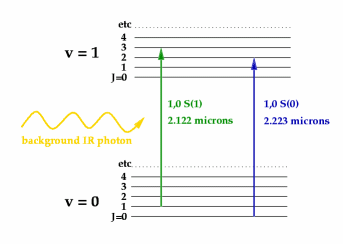 |
However, even if H2 cannot glow by its own light, it is in principle possible to detect H2 in absorption via those same intrinsically-weak infrared quadrupole lines or strong electric dipole lines in the vacuum ultraviolet. Ultraviolet detection of H2 was performed by the Copernicus satellite in the mid-1970's toward very tenuous diffuse interstellar clouds, and attempted in the 1980's via infrared line absorption towards dense molecular clouds, but high-resolution infrared spectrometers were not sensitive enough to detect the very weak H2 lines. With substantial recent improvements in the sensitivity of infrared detectors and high-resolution cooled array grating spectrometers, we can now detect cold H2 in dense clouds for the first time! |
Like H2, the pivotal H3+ ion is similarly invisible. H3+ is expected to be responsible for initiating the complex ion-neutral reactions that lead to the formation of most other molecules. Detection of this ion is critical for verification of our basic understanding of interstellar chemistry. Furthermore, H3+ results from nearly every cosmic-ray photoionization of H2, so measurement of H3+ can be used as a direct probe of the cosmic ray ionization rate in dense clouds, which is a critical and fundamental quantity for which no direct measurement exists! Via the same absorption line techniques as used for H2, we are also able to directly search for H3+ and can probe directly the physics of molecular clouds, addressing very basic, fundamental questions about their structure and physical processes that have not been previously and directly studyable.
So how do we do it? Young "protostars" are heavily embedded in the shroud of dusty molecular material from which they form, so they are not seen in visible light. However, longer-wavelength infrared light can penetrate these dusty cocoons, and these young stellar objects are readily detected as luminous infrared sources. We use these sources as simple "candles", as background light sources that can be used to probe the circumstellar and interstellar material in absorption along the line of sight from us to the star. One such source is the embedded massive star, unimaginatively called "IRS 2" (InfraRed Source #2) in NGC 2024, the Flame Nebula immediately adjacent to the famous Horsehead Nebula and the left (east) most belt star of Orion. The following is a multi-wavelength overview of the region.
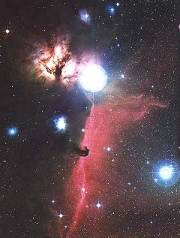 |
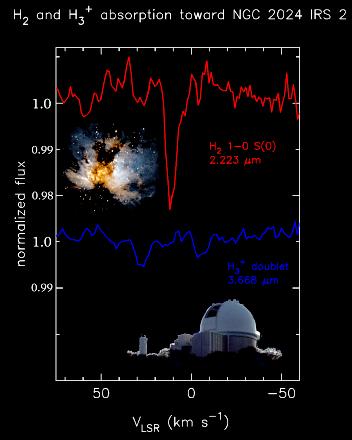 |
Furthermore, we can also easily observe CO along the same lines of sight in absorption, allowing us to compare the structure, excitation, and abundances of the infrared measurements of CO to more conventional emission-line (sub)millimeter wave studies of CO! Notice that many CO lines can be observed simultaneously, versus having to observe one line at a time at radio wavelengths, each time with a different receiver and often a different telescope!
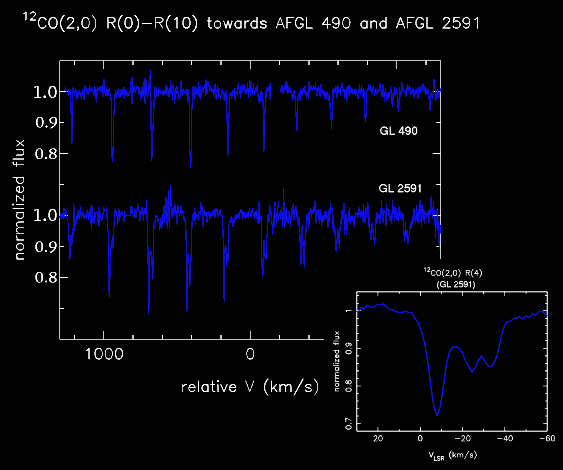
Thus high-resolution infrared spectroscopy has an important role in interstellar studies: crucial non-polar molecules like H2 and H3+ can be observed, and the abundances and excitation conditions can be cleanly referred to the same milliarcsecond absorbing column of gas. This allows much more accurate measurements of the environments of star formation than can be achieved by radio techniques.
 Back to Craig's Research Projects
Back to Craig's Research Projects
Craig Kulesa Last modified: Tue Apr 16 14:53:47 MST 2002